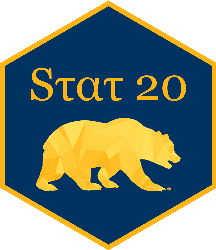15:00
Summarizing Numerical Data
STAT 20: Introduction to Probability and Statistics
Agenda
- Announcements
- Notes Recap
- Practice Concept Questions
- Coding Activity: Graphing Numerical Data
- Break
- Worksheet “Summarizing Numerical Data” (part of WSP-3)
- Lab 2.2 (time permitting)
Announcements
- RQ: Grammar of Graphics due Thursday at 11:59pm
Lab 2: Class Survey (both parts) due Tuesday at 8am
- Lab 2.1: Group submission
- Lab 2.2: Individual submission
Notes Recap
Summarizing Distributions of Data using:
- Graphics
- Numerical Summaries
Graphics
You can construct a statistical graphic to show the shape, which you can describe in terms of modality and skew
- Dot plot
- Histogram
- Density plot
- Violin plot
- Box plot
Measures of Center
You can calculate a measure of center to convey a sense of a typical (representative) observation
- Mean
- Median
- Mode
Measures of Spread
And you can calculate a measure of spread (i.e. scatter, dispersion, variation) to capture how much variability there is in the data
- Range
- Inter Quartile Range (IQR)
- Mean Absolute Deviation (MAD)
- Sample Variance (Var)
- Sample Standard Deviation (SD)
Typical value?
\[ 6 \quad 7 \quad 7 \quad 7 \quad 8 \quad 8 \quad 9 \quad 9 \quad 10 \quad 11 \quad 11\]
- sample size ( \(n\) ): 11
- mean ( \(\bar{x}\) ): 8.45
- median: 8
- mode: 7
How can we express the variability in this data set using a single number?
\[ 6 \quad 7 \quad 7 \quad 7 \quad 8 \quad 8 \quad 9 \quad 9 \quad 10 \quad 11 \quad 11\]
\[ {\Large 6} \quad 7 \quad 7 \quad 7 \quad 8 \quad 8 \quad 9 \quad 9 \quad 10 \quad 11 \quad {\Large 11}\]
The Range
\[\textrm{range:} \quad max - min\]
\[ 11 - 6 = 5\]
Characteristics
- Very sensitive to extreme values!
\[ 6 \quad 7 \quad {\Large 7 \quad 7} \quad 8 \quad {\large 8} \quad 9 \quad {\Large 9 \quad 10} \quad 11 \quad 11\]
The Inner Quartile Range (IQR)
The difference between the 3rd quartile, \(Q_3\), and the 1st quartile, \(Q_1\) (i.e. the middle 50% of the data)
\[\textrm{IQR:} \quad Q_3 - Q_1\]
\[ 9.5 - 7 = 2.5 \]
Characteristics
- Robust to outliers
- Used to set the width of the box in a boxplot
\[ 6 \quad 7 \quad 7 \quad 7 \quad 8 \quad 8 \quad 9 \quad 9 \quad 10 \quad 11 \quad 11\]
Mean Absolute Deviation
Take the differences from each observation, \(x_i\), to the sample mean, \(\bar{x}\), take their absolute values, add them up, and divide by \(n\). Simply put, this is the average distance from the mean.
\[MAD: \quad \frac{1}{n}\sum_{i = 1}^n |x_i - \bar{x}| \]
\[ MAD = 1.4 \]
Characteristics
- Incorporates information from all observations
- Robust to extreme values
\[ 6 \quad 7 \quad 7 \quad 7 \quad 8 \quad 8 \quad 9 \quad 9 \quad 10 \quad 11 \quad 11\]
Sample Variance
Take the differences from each observation, \(x_i\), to the sample mean, \(\bar{x}\), square them, add them up, and divide by \(n - 1\) .
\[s^2: \quad \frac{1}{n - 1}\sum_{i = 1}^n (x_i - \bar{x})^2 \]
\[ s^2 = 2.87 \]
Characteristics
- Incorporates information from all observations
- Moderately sensitive to extreme values
- Measured in squared units!
\[ 6 \quad 7 \quad 7 \quad 7 \quad 8 \quad 8 \quad 9 \quad 9 \quad 10 \quad 11 \quad 11\]
Sample Standard Deviation
Take the differences from each observation, \(x_i\), to the sample mean, \(\bar{x}\), square them, add them up, divide by \(n - 1\), then take the square root.
\[ S: \sqrt{\frac{1}{n - 1}\sum_{i = 1}^n (x_i - \bar{x})^2} \]
\[ s = 1.70 \]
Characteristics
- Incorporates info from all observations
- Moderately sensitive to extreme values
- Measured in units of the original data
Practice Concept Questions
Introducing ggplot2
Demo
tinyurl.com/ybhwtrr9
Coding Activity: Graphing Numerical Data
25:00
Break
05:00
Worksheet: Summarizing Numerical Data
30:00
Lab 2.2 Time Permitting
End of Lecture
